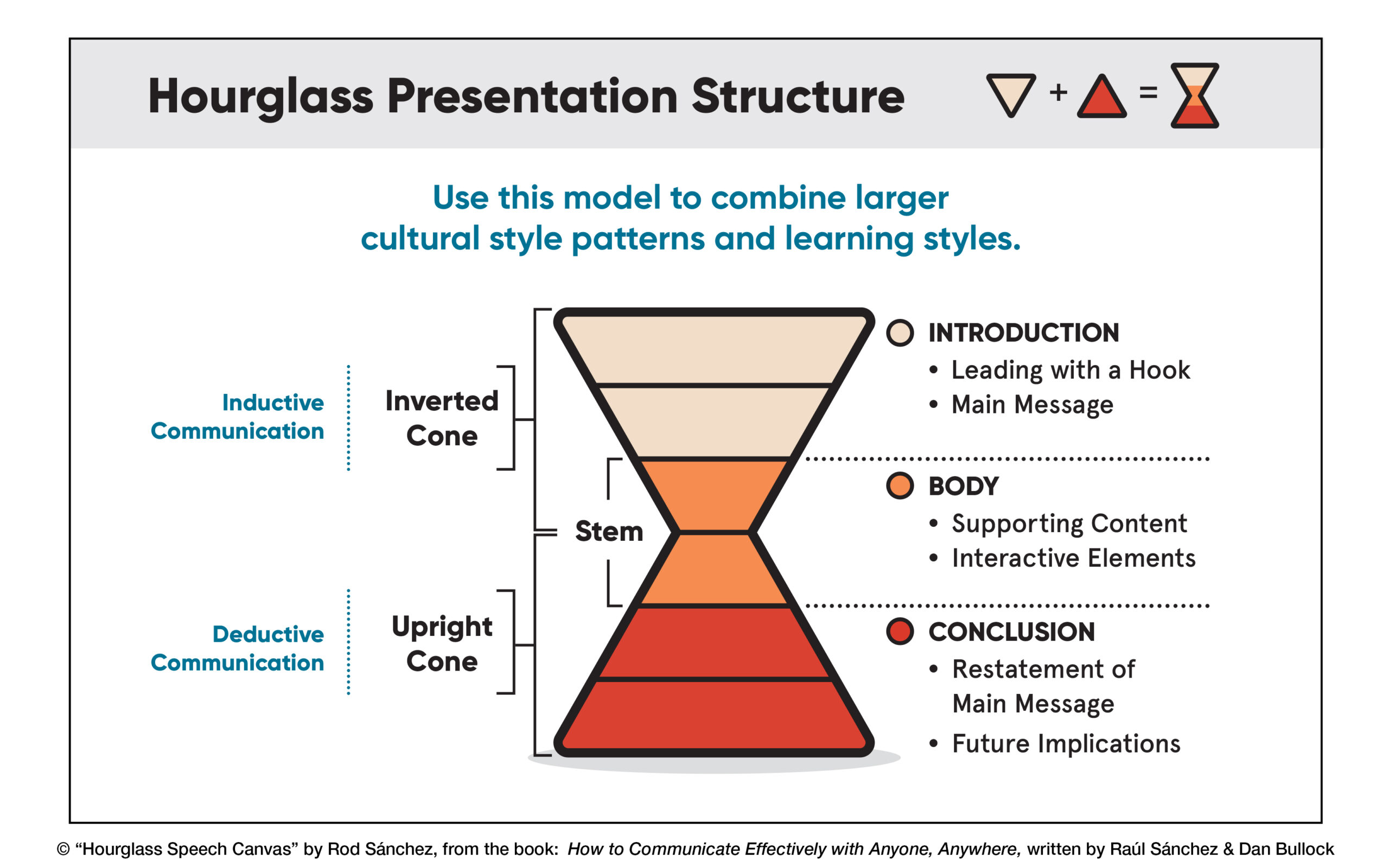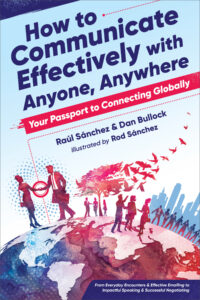Become a Global Communicator
What is the “blueprint” for global communication? Imagine speeding away from the earth into an astronaut’s perspective, seeing the communication patterns of all the countries in the world, and being able to navigate them as a global communicator. Whether through public speaking, effective emailing, networking, or negotiating, this set of culturally-powerful “blueprints” will completely change the way you communicate across the global marketplace
Having worked in global teams for decades, I enjoyed seeing these practical skills and strategies outlined in the book How to Communicate Effectively with Anyone, Anywhere. When the book crossed my desk, I reached out to the authors, Professor Raúl Sánchez and Professor Dan Bullock from New York University’s School of Professional Studies, and the illustrator, Rod Sánchez from Houghton Mifflin Harcourt for their thoughts on how to “upgrade” our skills to become more effective global communicators.
The book also offers a unique Augmented Reality (AR) reading experience where the illustrations have been designed to “come to life” in full animation and sound through your smartphone – giving readers a multi-sensory experience of the book in areas such as body language techniques and public speaking skills. More details about the book and its unique AR feature can be found here.
In a world seemingly more divided than ever, you take us to space to change our mindset. Would you talk a little about that perspective and why it is important to your work?
The most influential photograph ever taken was Earthrise, where astronauts brought to humanity our first glimpse of the fragility, beauty, and loneliness of our world. The image went as close to viral as an image could at that time, flooded by international media across the planet. The photographer and astronaut of the Apollo 8 mission, William Anders, said about that moment of turning around to look back, “We set out to explore the moon, but instead discovered the earth.”
The image was so powerful it helped launch the environmental movement. It’s said that the most powerful cognitive shift can happen when an astronaut views the earth and this viewpoint is said to be the key to sustainability and world peace. How can we bring this perspective to our interactions on earth in the global marketplace?
The reason we bring up this viewpoint at the beginning of the book is because this photograph offers us a timeless gift of perspective. A global mindset. It reminds us that all divisions and distances can become meaningless in a single worldview.
As global communicators, we too must bring ourselves to a similar and singular state of awareness – and the book reveals actionable ways for doing this across key performance areas, such as public speaking, effective emailing, and negotiation, so that we’re guided by the interconnectedness of the world within a global mindset. This transformative power already exists within the reach of our own consciousness; we just have to unlock it. And this mindset is the key to unlocking the skills of a global communicator.
Global communication patterns are often learned through trial and error. You share many of them to help prepare speakers in advance. Would you share one of them with us?
One core global communication skill, whether you are delivering a presentation in the virtual boardroom, or at a global business convention, is developing an international presentation style.
Our human desire to master presentation skills has origins more than 2,300 years ago, when Aristotle’s work Rhetoric laid out the first documented and systematic approach to persuasive public speaking. He outlined the three rhetorical appeals essential for persuasion—logos (appeal to logic), pathos (appeal to emotion), and ethos (appeal to credibility). These appeals are commonly referred to as “modes of persuasion.” We’ve adapted these appeals to the global context to create a simple model for developing an international presentation style that can accommodate a full global span of audience members in a practical way.
Essentially, to break it down, there are key global communication style preference patterns that exist around the world in relation to the presentation space. These patterns mirror cultural preferences for receiving information. Our work in this area draws from the Lewis Model by Linguist Richard Lewis and the research of intercultural anthropologist Edward T. Hall, while our unique model expanded in the book adapts this research to the global presentation situation.
Ultimately, the goal in any intercultural presentation is to integrate the three appeals into every presentation (such as including research/data for logos, emotional/impactful stories/media for pathos, and credibility/courtesy/empathy for ethos) that reflect all three style patterns of communication we explain further in the book. By doing so, you can reach a spectrum of audiences in the same presentation space. Merging the three rhetorical appeals with a core set of strategies is the key to developing an international presentation style.
What should we focus on when delivering a presentation?
When we present, we often first focus on ourselves – this mindset doesn’t just necessarily involve ego, we can also often be frozen in presentation anxiety. However, with a simple shift in mindset, we can deliver a presentation more impactfully from the global stage.
Service is the most important concept of presentations in the global context. Once we shift our mindset to that of “service,” then the audience becomes the centerpiece of our presentation. And this allows us to develop the adaptability necessary for intercultural communication to occur because we begin to adjust our communication to fit our audience.
With this mindset, we can also become aware of those two pillars of the global presentation space: content and delivery. Both pillars form the architecture of a successful presentation. What we say is just as important as how we say it, especially across cultures. We share practical tips for both of these areas within the book.
Service reframes the entire presentation context as one where we are delivering the torch of our ideas in service to our audience. Similar to world runners passing the Olympic torch across world communities, we are delivering ideas in service to others, passing the torch of our ideas and creating a space for empathy, inclusion, and respect.
Would you share a little about the hourglass presentation structure and how that can help?
While there isn’t a one-size-fits-all template for a presentation, the hourglass speech canvas is a presentation model that provides a single effective framework for global presentations. This unique presentation model is a presentation “map” that draws in and engages intercultural audiences across the world.
The hourglass structure essentially combines two ways of organizing information—an inverted cone and an upright cone–which targets two larger cultural dimensions coined by Edward T. Hall to describe two broad cultural style patterns: high-context and low-context communication styles. High-context communication styles tend to be a pattern of Eastern cultures with a focus on synthesis and on developing knowledge from multiple sources of information. On the other hand, low-context communication styles, tend to be a pattern of Western cultures with a focus on details and on developing knowledge from one statement, principle, or source. In the book we provide easy-to-implement ways to apply this “canvas” in your presentation.
When merged together as an “hourglass”– with combined deductive/inductive learning approaches – both patterns of communication build toward a unified presentation model that clearly and impactfully communicates information across the spectrum of global professionals.

I love your review of different greetings around the world. What are a few that are most memorable?
In the “Global Greeting Patterns” section of the book, one of the most notable global greetings stems from knowing how to express respect, as it is a universal value throughout the international community and is communicated in various ways, through the use of personal space, titles, or first names. Depending on levels of formality and with whom we are networking, we often need to make judgement calls when conversing across cultures. For example, initiating a handshake with everyone in a group in Switzerland and using proper titles/honorifics will not resonate the same way in China where traditional bows and handshakes are first only offered from the most senior person in the group.
Gender is another element to be mindful of during greetings as etiquette varies with men and women exchanging cheek-kissing in Colombia versus women initiating cordial handshake greetings in Turkey. Also, be mindful of religious customs, for example, forgoing the use of your left hand in countries with practicing Muslim traditions common in the Middle East, North Africa, and Indonesia.
Most importantly, as our world becomes more globalized, intercultural guides for business etiquette have begun to indicate that “greetings vary,” as Eastern cultures become more westernized and Western cultures become more aware of Eastern practices. Overall, intercultural awareness is becoming not only an essential mechanism for connecting people globally, but the key to a shared perspective and understanding.
Tell us more about the augmented reality component of the book.
The augmented reality (AR) component is a unique part of the book that further enhances the intercultural strategies shared. Our intention with utilizing this emerging technology is to create a new immersive reading and learning experience in support of the content in the book and to utilize it as a new audio/visual communication tool for global audiences. Selected illustrations have been designed by the illustrator and the authors in augmented reality to “come to life” with your smartphone revealing “hidden” practical tips and strategies. Readers can interact with the book’s content using their smartphone in an AR multi-sensory reading experience. The book’s illustrations animate in another layer to the physical book utilizing AR technology to unlock additional tips and demonstrate key business communication concepts, including body language techniques, international public speaking skills, and more.
To experience the augmented reality artwork, readers download the free app, Artivive, with their smartphone. Readers then hover their phone over selected artwork to view the artwork animate across the pages in full animation and sound.
What have you learned from writing this book that you didn’t know before you started?
 As a collaborative project between two writers and an illustrator in creating this book, we discovered that collaboration is the key to sparking deeper meanings in the creative process. For example, one night, the three of us met late for dinner to talk about the book.
As a collaborative project between two writers and an illustrator in creating this book, we discovered that collaboration is the key to sparking deeper meanings in the creative process. For example, one night, the three of us met late for dinner to talk about the book.
We talked about patterns of stars which eventually sparked a discussion of how Eastern and Western cultures view the same star clusters. World cultures recognize similar constellations, while simply giving those constellations different names. One idea led to another and we talked about how pattern recognition is a human trait, a trait that transcends culture. That night, we not only arrived at the unifying premise of the book – patterns of communication – but also deepened our own approach to being global communicators.
All art springs from collaboration. Whether we collaborate with the creative force or with the creativity of others – the exchange of ideas is what sparks art into existence. The creative force is like a spiritual current running through the world and wants us to collaborate with it. The creativity of others, over time and across the world, is always ready for our spark to spread their flames forward in time. And, in the global marketplace, collaboration is innovation, an innovation which occurs across time and societies as a network of sparks passed from one human being to the next, all around the planet.
For more information, see How to Communicate Effectively with Anyone, Anywhere.
Illustrations credited to Rod Sánchez.
More Quotes:

